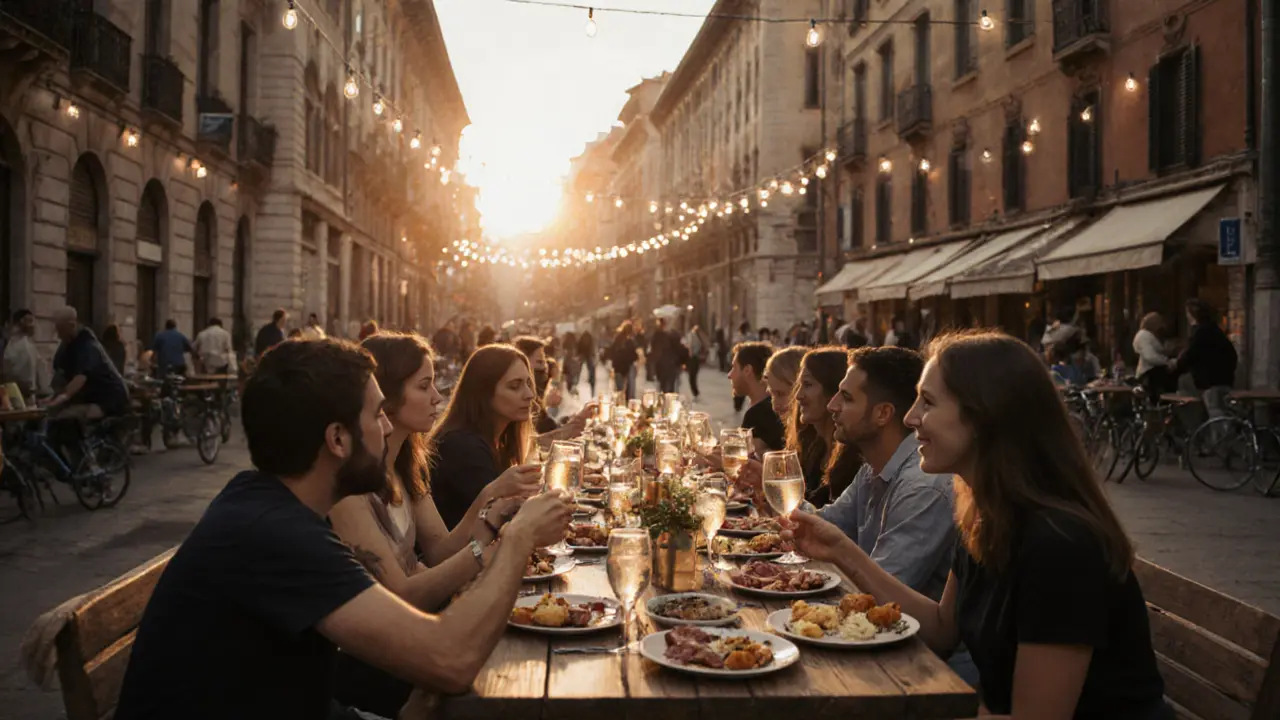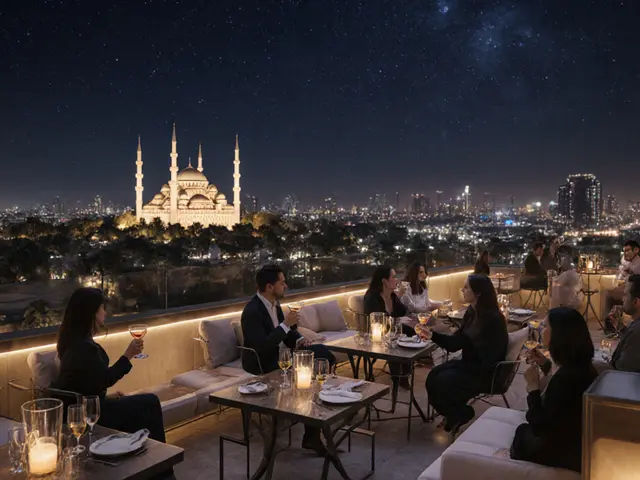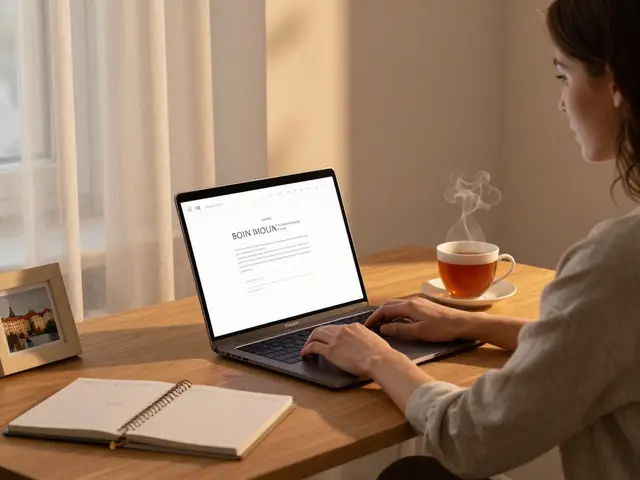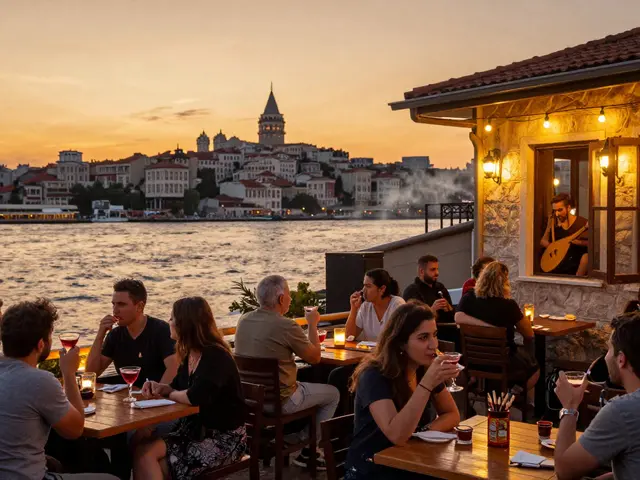Forget the fashion shows and the Duomo for a minute. When the sun sets in Milan, the city doesn’t sleep-it transforms. You won’t find tourist traps or overpriced cocktail lounges with fake Italian charm. You’ll find real people, real music, and real energy pulsing through narrow alleyways and hidden courtyards. This isn’t just a night out. It’s a ritual.
The Aperitivo Culture: Where Nightlife Begins
Don’t call it happy hour. In Milan, it’s aperitivo. And it’s not a drink with a snack. It’s a full meal served with your cocktail, usually between 7 and 9 p.m. You pay €12-€18, and you get unlimited access to a buffet that could feed three people. Think arancini, stuffed tomatoes, grilled vegetables, cured meats, and fresh bread. No one rushes you. You linger. You talk. You watch the city come alive.
Start in Brera. The streets here are lined with historic cafés and tucked-away wine bars. Try Bar Basso-famous for inventing the Negroni Sbagliato. Or head to La Cucina di Mamma, where the aperitivo spreads are legendary. Walk around. Watch locals clink glasses under string lights. This is where the night is born.
From Bars to Clubs: The Transition
After aperitivo, the crowd shifts. By 10 p.m., the bars thin out. The real action moves to the clubs. But Milan doesn’t have one nightlife district-it has five, each with its own vibe.
Porta Venezia is the queer-friendly, eclectic heart. Think underground techno in basements, drag shows with live bands, and bars that stay open until 6 a.m. La Scala isn’t the opera house here-it’s the name of a club with neon lights and a dance floor that shakes the walls.
Navigli is the romantic stretch. Canalside bars with wooden decks, live jazz on weekends, and people sipping spritzes as boats glide by. It’s slower, softer. Perfect if you want to end the night with a quiet conversation under the stars.
Corso Como is where the influencers and designers go. It’s sleek. It’s quiet. It’s expensive. But if you want to see Milan’s elite in their natural habitat-black turtlenecks, designer sneakers, and zero pretense-this is the place. Corso Como 10 is a cultural hub: art gallery by day, members-only club by night.
For pure dance energy, head to Alcatraz or Magazzini Generali. Alcatraz is a converted warehouse with industrial vibes and top international DJs. Magazzini Generali, near the train station, hosts everything from house to experimental electronica. Both have lines, but they move fast. No dress code beyond ‘don’t show up in sneakers and sweatpants’.
What to Wear: Milan’s Unwritten Rule
Milan doesn’t care if you’re rich. But it does care if you look like you tried.
Men: Dark jeans, a well-fitted shirt or slim sweater, clean leather shoes. No logos. No hats. No shorts. Ever.
Women: Think minimalist chic. A little black dress, tailored trousers, or a structured coat. Heels? Optional. But if you wear flats, make sure they’re stylish. No flip-flops. No backpacks. No sportswear.
This isn’t about being rich. It’s about being intentional. Milanese people notice details. A mismatched sock, a wrinkled shirt, or a cheap watch will stand out. You don’t need to spend €500. But you do need to look like you care.

When to Go: Timing Is Everything
Milan doesn’t start until midnight. Seriously.
Bars fill up around 9:30 p.m. Clubs don’t get busy until 1 a.m. And the real party? That’s at 3 a.m. You’ll see locals leaving restaurants at 11 p.m. and heading to clubs. That’s normal.
Weekends are packed. Friday and Saturday nights mean lines outside every major club. If you want to avoid the crowd, go on a Thursday. You’ll get better service, better music, and more space to dance. Some clubs even have special Thursday DJs who play deeper, weirder sets.
And don’t expect to walk in at 11 p.m. on a Saturday and get in easily. Most places have guest lists. If you don’t know someone, arrive early. Or ask your hotel concierge-they often have contacts.
Hidden Gems: Where the Locals Go
Most guides will send you to the same five spots. Here’s where the real insiders hang out.
- Bar Basso - Not just for cocktails. Go at 11 p.m. on a Tuesday. The bartender will ask your name and make you a drink based on your mood.
- Il Gattopardo - A speakeasy behind a bookshelf in the Brera district. You need a password. Ask for it at the bar next door.
- La Vineria - A tiny wine bar under a train bridge. No menu. Just ask what’s open. They’ll pour you a glass of something rare from Piedmont or Sicily.
- Club 13 - A basement club in the Porta Genova area. No sign. Just a red door. If you hear techno and see people dancing, you’re in.
These places don’t have Instagram accounts. They don’t advertise. They survive because the people who come back keep them alive.

What Not to Do
Don’t:
- Ask for a “Martini” without specifying if you want it dry, dirty, or with olives. In Milan, “Martini” means a specific thing.
- Order a cappuccino after 11 a.m. Locals will judge you. Espresso only after lunch.
- Try to haggle over drinks. Prices are fixed. You’re paying for the experience, not just the alcohol.
- Take photos of people without asking. Milanese privacy is sacred.
- Assume everyone speaks English. Learn two phrases: “Grazie” and “Un’altra, per favore.”
How to End the Night
Most clubs close by 5 a.m. But the night doesn’t end there.
Head to Bar Beppe in the Porta Romana area. It’s open 24 hours. You’ll find artists, musicians, and old men playing chess over espresso. It’s quiet. It’s real. It’s the perfect way to come down.
Or grab a slice of panettone from a bakery at 6 a.m. The best ones still use traditional recipes-no preservatives, no shortcuts. You’ll eat it with your hands, still warm, while the city slowly wakes up.
That’s Milan. It doesn’t just have a nightlife. It has a rhythm. And if you match it, you’ll leave with more than a story. You’ll leave with a memory that feels like home.
What’s the best time to start a night out in Milan?
Start with aperitivo around 7 p.m. to 9 p.m. Most bars fill up by 9:30 p.m., and clubs don’t get busy until after midnight. The real party kicks off around 3 a.m., so plan accordingly. Don’t expect to go clubbing at 10 p.m.-that’s dinner time here.
Do I need to make reservations for Milan clubs?
For popular clubs like Alcatraz or Magazzini Generali on weekends, yes. Arrive early or ask your hotel concierge for help getting on the guest list. Smaller spots like Club 13 or La Vineria don’t take reservations-they’re first come, first served. If you’re unsure, call ahead or check their Instagram stories for updates.
Is Milan nightlife safe for solo travelers?
Yes, but stay aware. Milan’s nightlife areas are generally safe, especially in well-lit, busy zones like Navigli and Porta Venezia. Avoid walking alone through empty streets after 3 a.m. Stick to main roads. Use taxis or ride-share apps if you’re tired. Never leave your drink unattended.
How much should I budget for a night out in Milan?
Plan for €30-€60 per person. Aperitivo costs €12-€18 and includes food. Drinks at bars range from €8-€15. Club entry is usually free before midnight, then €10-€20 after. If you’re eating late or ordering premium cocktails, add another €10-€20. You don’t need to spend a lot to have a great night.
Are there any dress codes I should know about?
Yes. Milan has an unspoken dress code. No sneakers, no shorts, no sportswear. Men: dark jeans, button-down shirt, clean shoes. Women: minimalist dresses, tailored pants, or stylish coats. You don’t need designer labels, but you do need to look put together. Clubs like Corso Como 10 are stricter-some won’t let you in if you’re wearing a hoodie.
What’s the best way to get around Milan at night?
The metro runs until 1:30 a.m. on weekdays and 2:30 a.m. on weekends. After that, use apps like FreeNow or Uber. Taxis are reliable but expensive-expect €10-€20 for a short ride. Walking is fine in central areas like Brera or Navigli, but avoid isolated streets after midnight. Always check your route before heading out.









